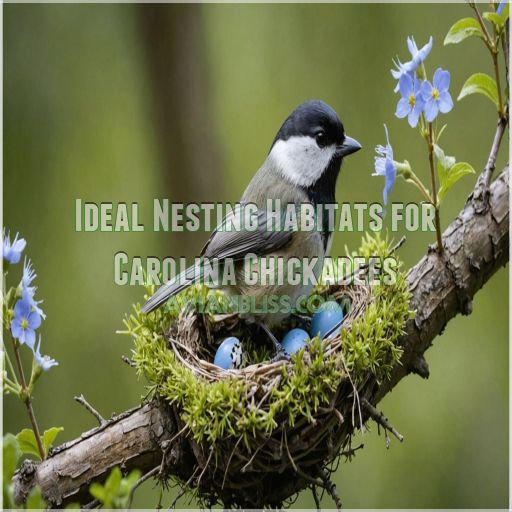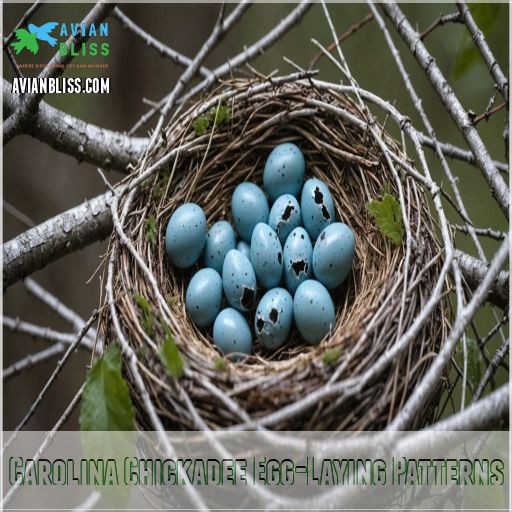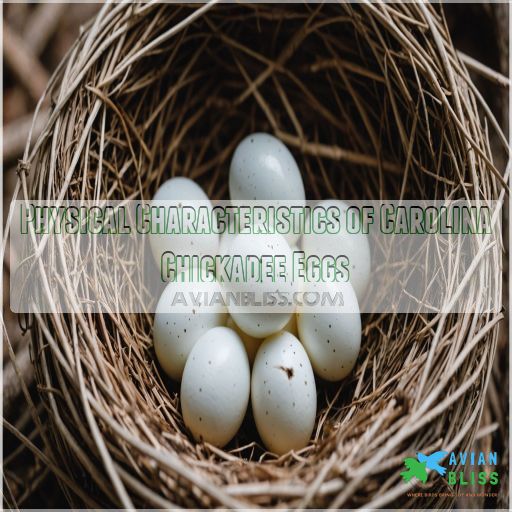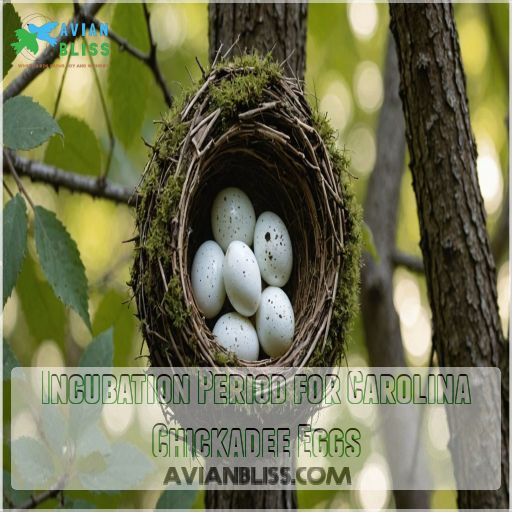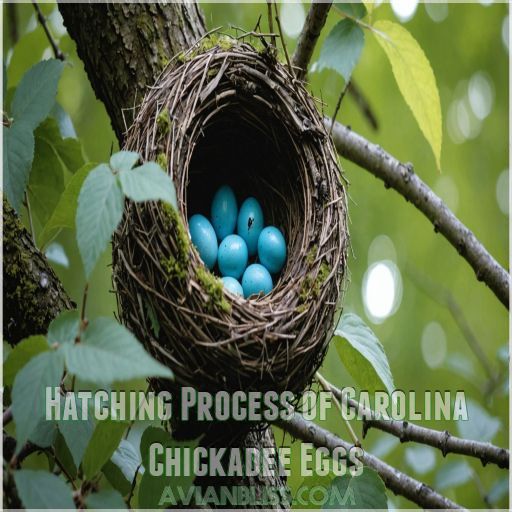This site is supported by our readers. We may earn a commission, at no cost to you, if you purchase through links.
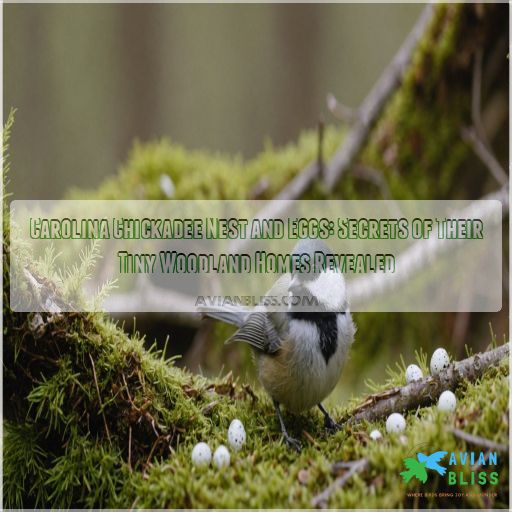
These birds nest in natural cavities or old woodpecker holes, favoring locations 6 to 15 feet above ground for a panoramic view and predator protection.
The female is the interior designer, crafting a cushy nest of moss, fur, and feathers.
Expect a clutch of 4 to 8 speckled white eggs, incubated for 12 to 15 days.
With attentive parental care, these eggs transform into sightless, featherless chicks.
Curious about the chickadees’ picky nesting preferences or how they manage threats? Stick around for more intriguing insights!
Table Of Contents
- Key Takeaways
- Carolina Chickadee Nesting Season and Timing
- Ideal Nesting Habitats for Carolina Chickadees
- Carolina Chickadee Nest Construction Techniques
- Carolina Chickadee Egg-Laying Patterns
- Physical Characteristics of Carolina Chickadee Eggs
- Incubation Period for Carolina Chickadee Eggs
- Hatching Process of Carolina Chickadee Eggs
- Nest Reuse and Site Fidelity
- Threats to Carolina Chickadee Nests and Eggs
- Conservation Efforts for Carolina Chickadee Nesting
- Frequently Asked Questions (FAQs)
- When do Carolina chickadees start nesting?
- How often do Carolina chickadees lay eggs?
- How long do Carolina chickadees incubate eggs?
- How do Carolina chickadees build a nest?
- What do Carolina chickadee eggs look like?
- What month do chickadees lay eggs?
- Do chickadees come back to the same nest every year?
- What kind of nest does the Carolina chickadee have?
- How do Carolina Chickadees choose nesting sites?
- What are common predators of chickadee nests?
- How to increase fledging success for chickadees?
- Do chickadees compete with nuthatches for nests?
- Is chickadee nesting affected by climate changes?
- Conclusion
Key Takeaways
- You’ll find that Carolina chickadees are picky home builders, preferring natural cavities or old woodpecker holes 6 to 15 feet up for a bird’s-eye view and predator protection. These feathered architects craft cozy nests using moss, fur, and feathers – it’s as if they’re creating a tiny woodland treehouse.
- When it comes to eggs, Carolina chickadees don’t put all their eggs in one basket. They typically lay 4 to 8 speckled white eggs, which are about the size of a jelly bean. The female takes charge of incubation for 12 to 15 days, turning her eggs several times daily, much like a dedicated chef tending to her soufflé.
- You might think that these birds are homebodies, but they’re actually quite particular about their real estate. While they may return to successful nesting spots, they often build new nests each year. It’s as if they’re participating in their own avian version of "House Hunters."
- If you want to be a chickadee landlord, consider setting up nest boxes in your backyard. However, be aware that these tiny tenants face threats from predators, parasites, and environmental hazards. By participating in citizen science projects or educational outreach, you can help ensure that these charming birds keep chirping for generations to come.
Carolina Chickadee Nesting Season and Timing
You’re about to peek into the hidden world of Carolina Chickadee nesting, where these tiny birds create cozy homes for their families.
From pair formation to egg-laying, you’ll discover the fascinating timeline of how these feathered architects build their woodland nurseries.
Breeding Period
While Carolina chickadees may seem carefree all year round, their breeding season is a well-timed affair.
You’ll find these tiny songbirds getting down to family business from early April through July . During this period, the woods come alive with their cheerful calls as they busily prepare for parenthood.
It’s a time of heightened activity, when these feathered friends transform from winter flock members to dedicated parents-to-be.
Pair Formation
You’ve seen Carolina chickadees flitting about your feeders, but did you know their love stories begin long before spring. These tiny lovebirds start pairing up in winter flocks .
- Flirty foraging: Couples search for food together
- Sweet serenades: Males sing "fee-bee" to woo their mates
- Food gifts: He brings her tasty morsels
- Territory tussles: Pairs defend their future home
As days lengthen, these partnerships strengthen, preparing for the nesting season to begin and the territory to be expanded (Source) and the romance to be cemented to raise a family together
Nest Site Selection
Once spring arrives, Carolina Chickadees begin their quest for the perfect nesting spot.
You’ll find these tiny architects scouting out potential homes in deciduous and mixed forests, often favoring dead or decaying trees.
They’re picky about their digs, seeking cavities that strike the right balance between size, tree health, and protection from predators.
Some chickadees even show site fidelity, returning to successful nesting locations year after year.
Nest Construction Timeline
After choosing the perfect spot, Carolina chickadees don’t waste time. They’ll start gathering nest materials like moss, bark strips, and soft plant fibers. You’ll see these tiny architects hard at work, carefully crafting their cozy homes.
The female takes charge of building the nest cup, carefully lining it with hair or plant down .
This intricate process typically unfolds during their breeding period from early April through July.
Ideal Nesting Habitats for Carolina Chickadees
You might think Carolina Chickadees aren’t picky about where they set up shop, but these little birds have some surprisingly specific preferences for their nesting spots.
Let’s explore the ideal habitats where these feathered architects build their cozy woodland homes and raise their families, specifically looking at the characteristics that define these woodland homes.
Preferred Tree Types
Carolina chickadees have a keen eye for their arboreal abodes. When selecting the perfect tree for nesting, these feathered architects show a strong preference for native species .
You’ll often find them setting up shop in:
- Dead trees or stumps
- Deciduous trees like redbud and sweetgum
- Coniferous trees, particularly pines
These picky birds aren’t just looking for any old tree – they’re after homes that offer both safety and a buffet of insects for their future chicks .
Cavity Characteristics
Inside the cozy confines of a tree, Carolina Chickadees seek out the perfect cavity for their nest. You’ll find these tiny architects prefer snug spaces with specific dimensions.
| Characteristic | Preferred Range |
|---|---|
| Cavity depth | 21 cm (avg.) |
| Entrance size | Small, snug fit |
| Wood type | Soft, decaying |
| Tree species | Alder, birch |
| Cavity shape | Cup-like bottom |
These picky nesters often excavate their own homes, turning a rotten branch into a cozy nursery.
Nest Height From Ground
While you might think Carolina Chickadees nest high in the treetops, they actually prefer a more modest height for their tiny homes. You’ll find their nests anywhere from 4 to 15 feet above the ground.
This height range offers several advantages:
- Easy access for busy parent birds
- Protection from ground-dwelling predators
- Shelter from harsh weather conditions
- Camouflage among leafy branches
Choosing the right height is like finding that Goldilocks zone – not too high, not too low, but just right for these charming little birds.
Proximity to Food Sources
In the blink of an eye, Carolina Chickadees can dart from their nests to nearby food sources.
You’ll find these clever birds nesting within 30 feet of prime foraging spots . They’re masters at balancing food abundance with predator risk.
Check out this handy table to understand their nesting strategy:
| Factor | Impact | Chickadee Solution |
|---|---|---|
| Food Proximity | Foraging Efficiency | Nest within 30 feet |
| Predator Risk | Safety | Choose concealed locations |
| Food Caching | Winter Survival | Select areas with hiding spots |
Carolina Chickadee Nest Construction Techniques
You’re about to uncover the intricate craftsmanship of Carolina Chickadee nests, from their careful cavity excavation to the cozy cup they build inside.
Get ready to explore how these tiny architects use nature’s materials and teamwork to create the perfect nursery for their precious eggs.
Cavity Excavation Process
You’d be amazed to watch a Carolina Chickadee excavate its nest cavity.
These tiny architects use their sharp beaks as chisels, pecking away at dead or decaying wood (Source). They’re not picky about tree species, but they do prefer softer woods that are easier to work with.
The process can take days or even weeks, depending on the wood’s hardness and the birds’ determination. The overall process is a testament to the birds’ tiny architects abilities.
Nest Materials Used
Crafty little architects, Carolina chickadees are masters of nest construction.
You’ll be amazed at their material choices:
- Mossy foundation: They start with a cozy layer of green moss.
- Bark-infused middle: Peeled bark is mixed in for structural integrity.
- Fur-lined luxury: The final touch is a soft lining of animal fur.
These resourceful birds gather materials from their surroundings, creating a snug home that’s both practical and comfortable. It’s like they’re building a tiny, woodland treehouse!
Nest Cup Dimensions
Carolina Chickadees craft tiny homes with precision.
The nest cup, a cozy cradle for their eggs, measures about 2 3/8 inches across and 1 inch deep .
It’s like a miniature tea cup nestled within the cavity.
This snug fit helps keep the eggs warm and secure.
You’ll find the cup lined with soft materials, creating a plush interior that’s just right for incubating their precious clutch.
Male and Female Roles in Building
While both male and female Carolina Chickadees pitch in to build their cozy home, they’ve got distinct roles.
The female takes the lead, crafting the nest base with moss and bark strips. She’s the interior designer, adding a plush lining of hair or plant fibers.
Meanwhile, her partner might help excavate the cavity or scout for the perfect spot. It’s teamwork at its finest in the bird world!
Carolina Chickadee Egg-Laying Patterns
You’re about to discover the fascinating egg-laying habits of Carolina chickadees, those tiny woodland acrobats.
From their clutch sizes to the timing of their egg production, you’ll get an inside look at how these feathered parents-to-be prepare for their next generation like the blue jay
.
Clutch Size
Now that you’ve learned about nest construction, let’s explore the fascinating world of Carolina chickadee clutch sizes.
You’ll find these tiny birds typically lay 6 eggs, though the number can range from 5 to 8.
Their close relatives, the black-capped chickadees, have an even wider range of 1-13 eggs per clutch.
Factors like food abundance and nest site quality can influence how many eggs a pair produces.
Egg-Laying Frequency
Did you know that Carolina Chickadees are like clockwork in terms of laying eggs?
These tiny architects of the woodland typically lay one egg per day until their clutch is complete.
You’ll find that a full clutch usually consists of about six eggs.
This steady rhythm allows the female to conserve energy while ensuring all her eggs have an equal chance at hatching successfully.
The female’s steady egg-laying pattern helps her to conserve energy and also ensures that all of her eggs have an equal chance at hatching.
Seasonal Variations in Egg Production
Throughout the year, Carolina chickadees adjust their egg production to match nature’s rhythm. You’ll notice these feathered architects fine-tuning their reproductive strategies:
- Laying typically kicks off in mid-April, when spring’s bounty is in full swing
- Peak egg-laying often coincides with the emergence of caterpillars, their favorite food source
- Late summer nests might have smaller clutches as resources dwindle
As the seasons waltz by, these tiny builders choreograph their family planning to Mother Nature’s tune.
Factors Affecting Clutch Size
You might be surprised by the factors that influence a Carolina Chickadee’s clutch size. These tiny birds consider a variety of conditions when deciding how many eggs to lay.
Let’s take a peek at the main factors:
| Factor | Impact | Example |
|---|---|---|
| Food availability | High | More insects = larger clutch |
| Habitat quality | Moderate | Dense forests favor breeding |
| Weather conditions | Variable | Mild springs boost egg count |
Remember, chickadees typically lay 6-8 eggs per clutch, but this can vary based on these factors.
Physical Characteristics of Carolina Chickadee Eggs
You’re about to peek into the tiny world of Carolina chickadee eggs, where every speckle tells a story.
These minuscule marvels, no bigger than your fingertip, hold the secrets of a new generation waiting to hatch in cozy woodland nests.
Egg Size and Shape
Carolina chickadee eggs are tiny marvels of nature. You’ll find these little gems measuring about 0.6 inches (1.5 cm) in length and 0.5 inches (1.2 cm) in width. That’s roughly the size of a jelly bean.
Their shape is typically oval, but don’t be surprised if you spot some slight variations.
These compact eggs are perfectly suited for the snug cavities where chickadees make their cozy homes. They are little gems.
Shell Color and Markings
Now, let’s take a closer look at the shell color and markings of Carolina Chickadee eggs.
You’ll find these tiny treasures are like nature’s Easter eggs, with a white or cream-colored base adorned with fine reddish-brown spots or dots.
The speckles often cluster more densely at the larger end, creating a charming freckled appearance.
Their smooth shells have little to no gloss, giving them a subtle, matte finish .
Variations in Egg Appearance
Three key factors influence the appearance of Carolina chickadee eggs, creating a fascinating range of variations.
You’ll find that these tiny treasures can differ in:
- Color intensity
- Speckle density
- Overall size
- Shell texture
While the base color remains white to cream, the speckles can range from sparse to dense, creating unique patterns.
Environmental factors and the mother’s health play a major role in determining these variations, making each clutch a one-of-a-kind masterpiece in nature’s gallery.
Comparison to Other Chickadee Species’ Eggs
When you compare Carolina Chickadee eggs to their feathered cousins, you’ll notice some fascinating differences.
Let’s take a peek at how these tiny treasures stack up:
| Species | Egg Size | Color Pattern | Shell Texture |
|---|---|---|---|
| Carolina Chickadee | Smallest | White with reddish-brown specks | Matte |
| Black-capped Chickadee | Slightly larger | Similar to Carolina | Slightly glossy |
| Mountain Chickadee | Comparable to Black-capped | Fewer specks | Smooth |
| Tufted Titmouse | Noticeably larger | Denser speckling | Semi-glossy |
While they’re all little bundles of joy, Carolina Chickadee eggs are the true pocket-sized wonders of the bunch!
Incubation Period for Carolina Chickadee Eggs
You’re about to peek into the cozy world of Carolina Chickadee egg incubation, where these tiny birds show impressive dedication to their future chicks.
Get ready to discover secret rhythms and rituals that unfold in their snug Tufted Titmouse nesting habits as they nurture their precious eggs
.
Duration of Incubation
After the female lays her eggs, you’ll witness a fascinating period of patience and dedication. The incubation period for Carolina chickadee eggs typically lasts 13 days.
During this time, you might observe:
- Constant warmth maintained at around 100°F
- Eggs turned several times daily
- Brief feeding breaks for the incubating parent
- Subtle movements as embryos develop
It’s like watching nature’s tiniest slow cooker in action! The parents’ commitment during this stage is truly remarkable.
Incubation Responsibilities
The Carolina chickadee’s incubation responsibilities are a true labor of love.
You’ll find that the female takes on the lion’s share of egg-warming duties, spending most of her time in the nest.
While she’s busy keeping those precious eggs toasty, her mate isn’t just twiddling his feathers.
He’s out there foraging and bringing her meals, ensuring she stays well-fed during her important vigil .
Incubation Behavior
During incubation, Carolina chickadees exhibit fascinating behaviors to make sure their eggs develop properly. You’ll notice these attentive parents:
- Take turns sitting on the eggs, with females typically doing most of the work
- Rotate eggs gently to maintain even heating
- Leave the nest briefly for quick feeding breaks
- Communicate with soft chirps to coordinate incubation shifts
These dedicated birds invest 12-15 days in this important phase, carefully nurturing their future chicks. It’s like they’re running a tiny, feathered daycare in the woods!
Temperature Regulation During Incubation
Carolina Chickadees have mastered the art of keeping their eggs at just the right temperature.
You’ll find these clever birds adjusting their sitting time based on the outside temperature. When it’s chilly, they’ll snuggle up for longer periods, but on warmer days, they’ll take more frequent breaks.
It’s like they’ve a built-in thermostat! Their brood patches act as sensitive thermometers, helping them fine-tune their incubation strategy as needed.
Hatching Process of Carolina Chickadee Eggs
You’re about to witness one of nature’s most amazing transformations right in your backyard.
As Carolina chickadee eggs prepare to hatch, you’ll see a flurry of activity from both parents and chicks that marks the beginning of a new generation of these charming woodland birds, a new generation.
Signs of Imminent Hatching
As the incubation period nears its end, you’ll notice exciting signs that hatching is imminent.
Keep an eye out for egg-shell thinning, which occurs as the chick absorbs calcium from the shell.
Listen closely for tiny piping sounds coming from inside the eggs – it’s the chicks’ way of saying "I’m almost here!"
You might also observe increased parental activity around the nest, as mom and dad prepare for their new arrivals, which is a sign that hatching is almost here .
Hatching Sequence
Imagine this: a tiny chickadee egg begins its hatching dance, tapping gently from inside.
The process is delicate, with each chickadee developing at its own pace. They’ll break through in the order laid, a surprisingly organized affair!
This suspenseful scene unfolds under careful incubation, with hatchlings ready to step—or flap—into their new world, a moment of great hatching dance.
Parental Behavior During Hatching
During the hatching process, parents diligently care for their newborn chickadees. Here’s a peek at their parental roles:
- Hatchling care: The female stays close, ensuring warmth and protection. Female Carolina chickadees can be seen taking care of their young in natural tree cavities or abandoned woodpecker holes, often utilizing nest boxes. They carefully line these spaces with plant down and animal hair to create a cozy environment.
- Nestling feeding: Both parents busily fetch food, satisfying those tiny, hungry beaks. As insect hunters, the Carolina chickadees collect a variety of insects, seeds, and berries to feed their young, teaching them essential survival skills.
- Brood defense: Ever watchful, they guard against intruders, ensuring their brood’s safety.
It’s a nurturing ballet of nature!
Removal of Eggshells
You’ve witnessed the chicks hatch; now it’s all about eggshell removal.
Those dedicated chickadee parents don’t miss a beat. They take on the task of keeping the nest tidy and hygienic, always ensuring a swift cleanup operation.
| Behavior | Action |
|---|---|
| Eggshell | Removed |
| Nest Hygiene | Improved |
| Parent Involvement | High |
| Nest Sanitation | Maintained |
| Egg Disposal | Swift |
A clean home means healthy chicks!
Nest Reuse and Site Fidelity
You’re about to explore the fascinating world of Carolina Chickadee nests, where these little architects might surprise you with their commitment, occasionally recycling nest sites like nature’s clean-up crew.
When spring rolls around, these tiny birds become fiercely territorial, ensuring last year’s real estate stays predator-free and perfectly suited for another brood, maintaining nature’s clean-up crew.
Annual Nest Site Selection
Carolina chickadees often reuse their nests or select a new site nearby, exhibiting strong nest site fidelity.
You might be wondering, why the loyalty to a specific spot?
Research suggests that cavity reuse and site fidelity are influenced by the quality of the nesting site, including the presence of food, safety, and suitable nesting trees.
Factors Influencing Nest Reuse
When it comes to nest reuse, Carolina chickadees consider a few key factors.
First, they’ll check if the previous nest was successful – did the chicks fledge without incident?
Next, they assess the nest site’s quality and whether predator pressure has changed.
Nest Cleaning and Renovation
Nest hygiene for a Carolina Chickadee might seem like a spring-cleaning charade, but it’s important for cavity maintenance. Think of it as room service with a touch of nest renovation magic—material replacement that decreases parasite potential.
Cleaning frequency? Once nesting season ends, give it a scrub! It’s a cozy renewal, welcoming new tenants without the fuss of old feathers lingering.
| Task | Frequency | Benefit |
|---|---|---|
| Nest Hygiene | End of Nesting Season | Reduces Parasite Risk |
| Material Replacement | Post-Fledging | Makes Sure Fresh Start |
| Cavity Maintenance | Annual | Encourages New Tenants |
Territorial Behavior Around Nest Sites
You might think chickadees are all about sharing, but when it comes to their nest sites, they’re fiercely independent. Think of it like their little piece of heaven – they’ll defend it with all their might! They’ll often reuse the same cavity year after year, and sometimes even clean it up before moving back in.
- Singing their hearts out, especially during mating season, to let everyone know who’s boss.
- Chasing away other chickadees and even sometimes larger birds that might be looking for a quick meal.
- Working together as a pair to defend their territory from intruders.
Threats to Carolina Chickadee Nests and Eggs
When you’re out exploring, keep an eye out for the clever Carolina chickadees.
These birds face quite the juggling act protecting their nests.
Between bold predators, unpredictable weather, and those pesky parasites, these tiny birds have their work cut out for them with a challenging task that requires great skill and precision, a true juggling act.
Predators of Eggs and Nestlings
Carolina chickadee nests encounter various threats, and nestling vulnerability is no laughing matter!
Predators like raccoons, snakes, and even opportunistic squirrels have adaptations that make accessing these nests all too easy.
Employing defense strategies, such as installing stovepipe baffles, can reduce nest predation rates a great deal.
These measures help protect chickadees, but they also have broader conservation implications, safeguarding your backyard’s smallest residents.
Environmental Hazards
Environmental hazards like habitat loss, climate change, pesticide use, light pollution, and invasive species create a challenging world for Carolina chickadee nests.
Imagine surviving a storm with pesticide rain or seeing your home bulldozed for new developments.
Even small changes, like unusual light, can disrupt these tiny birds’ woodland lives, making survival feel like a wild roller coaster ride.
Nest Parasitism
Brood parasitism can feel like an evolutionary arms race, especially when Brown-headed Cowbirds swoop in.
- Cowbirds lay eggs in nests of unsuspecting hosts like chickadees, often taking advantage of the nest materials used by house sparrows to lay their own eggs
.
- Nestlings must compete with demanding cowbird chicks.
- Host defenses may attempt to remove foreign eggs.
- Despite the odds, some chickadee nestlings survive this nest invasion.
Conservation Efforts for Carolina Chickadee Nesting
If you want to help Carolina Chickadees thrive, you’re encouraged to support conservation efforts like artificial nest box programs and habitat preservation.
You might not have feathers, but with citizen science projects and educational outreach, you can contribute to safeguarding their cozy woodland homes.
Artificial Nest Box Programs
If your backyard abuts a wooded area, consider installing a chickadee-friendly nest box program.
Strategically place boxes in tall trees, monitor them regularly, and enjoy watching these charismatic birds raise their young.
With a little effort, you can help boost local chickadee populations and delight in their cheerful antics all season long.
Habitat Preservation Initiatives
While artificial nest boxes play their part, keeping the Carolina Chickadee singing sweetly means tackling habitat loss and urban sprawl head-on.
Efforts such as:
- Protecting mixed woodlands from invasive species
- Combatting forest fragmentation
- Preserving riparian zones from climate change impacts
These steps help make sure these charming birds have safe, stable homes.
Citizen Science Monitoring Projects
Citizen science projects like NestWatch make monitoring Carolina Chickadee nests a breeze.
You can join these efforts, helping analyze data and evaluate the impact of nesting trends.
Volunteer recruitment is a key element, ensuring robust data quality and effective monitoring methods.
As you track these delightful birds, you’re contributing to important conservation data with a smile.
Educational Outreach on Nesting Practices
Engage your community with nest box design workshops to promote chickadee conservation and habitat restoration.
By sharing hands-on nest monitoring tips, you can spark enthusiasm and belonging among young and old alike—it’s a real hoot!
Encourage citizen science projects to make a tangible impact on local ecosystems, ensuring these charming little birds continue to thrive in your backyard.
Frequently Asked Questions (FAQs)
When do Carolina chickadees start nesting?
In the blink of an eye, Carolina chickadees jump into nesting season.
From early April through July, they build homes from moss and feathers with great care.
You’ll find them bustling about, preparing their cozy nests.
How often do Carolina chickadees lay eggs?
Carolina chickadees typically lay 6 eggs in late March to April . They’ll often keep the same breeding partner for 2 years or more, a long time for a songbird!
How long do Carolina chickadees incubate eggs?
You’ll find Carolina chickadee eggs incubate for an average of 13 days, typically ranging from 12 to 15 days.
These diligent little birds patiently sit while singing their tunes, ensuring their young emerge strong and chirpy.
How do Carolina chickadees build a nest?
Picture a crafty builder at work!
These birds dig out cavities, usually picking spots in dead wood.
The female lines the nest with moss and soft materials like rabbit fur, crafting a cozy, hidden home.
What do Carolina chickadee eggs look like?
Stumble upon these petite wonders in nature:
Chickadee eggs are white or cream with charming reddish-brown speckles, often concentrated at the larger end, like a sprinkle of freckles on a porcelain canvas.
What month do chickadees lay eggs?
Chickadees start laying eggs from April through early May.
You’ll often find their nests in cavities of trees, where they lay one egg a day until reaching a typical clutch size of 5 to 8 eggs.
Do chickadees come back to the same nest every year?
You might wonder if chickadees revisit familiar nests.
Research suggests they don’t typically reuse nests year after year.
Instead, they often build new ones or take over existing cavities, like those of other birds.
What kind of nest does the Carolina chickadee have?
Carolina Chickadees craft their nests in cavities, often in dead trees or nest boxes.
The female lines the nest with moss, bark strips, and a cozy layer of hair or plant fibers, creating a snug, nature-designed nursery.
How do Carolina Chickadees choose nesting sites?
Despite increased predation near edges, these birds favor sites close to them, possibly for better access to resources.
They also prefer decaying snags or branches, suggesting they’re not just about safety but also location appeal.
What are common predators of chickadee nests?
Predators like raccoons, snakes, and cats pose significant threats to chickadee nests, as do crows and squirrels.
Cardinals value safety in numbers, so attract a flock with these tips and watch your backyard transform into a bustling bird paradise
.
How to increase fledging success for chickadees?
Picture a cozy nestbox tucked away in tall trees.
To boost your chickadees’ fledging success, provide ample parental care, protect against predators, and make sure a safe environment.
Extend care by a week to halve mortality rates (Source).
Monitor nests regularly.
Do chickadees compete with nuthatches for nests?
You bet chickadees compete with nuthatches for nests!
These feathered neighbors often duke it out for prime real estate.
While they’re both small cavity-nesters, chickadees can be surprisingly scrappy, sometimes even booting out nuthatches from their chosen homes.
Is chickadee nesting affected by climate changes?
Climate changes are affecting chickadee nesting.
You’ll find they’re facing a tricky balancing act between average temperatures, extreme weather events, and food availability.
This juggling act is becoming more challenging as warming patterns shift , particularly due to warming patterns.
Conclusion
Imagine a tiny woodland architect, carefully crafting its perfect home.
That’s your Carolina chickadee, building its nest and laying eggs with care. You’ve now peeked into their cozy world, from nest construction to egg incubation.
Remember, these feathered friends face challenges, but you can help. By preserving habitats and providing nest boxes, you’re supporting the next generation of chickadees.
So next time you hear that familiar "chick-a-dee-dee-dee," think of the intricate nests and speckled eggs hidden nearby, waiting to hatch into new life.


